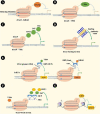CRISPR/Cas: From Tumor Gene Editing to T Cell-Based Immunotherapy of Cancer
- PMID: 33117331
- PMCID: PMC7553049
- DOI: 10.3389/fimmu.2020.02062
CRISPR/Cas: From Tumor Gene Editing to T Cell-Based Immunotherapy of Cancer
Abstract
The clustered regularly interspaced short palindromic repeats system has demonstrated considerable advantages over other nuclease-based genome editing tools due to its high accuracy, efficiency, and strong specificity. Given that cancer is caused by an excessive accumulation of mutations that lead to the activation of oncogenes and inactivation of tumor suppressor genes, the CRISPR/Cas9 system is a therapy of choice for tumor genome editing and treatment. In defining its superior use, we have reviewed the novel applications of the CRISPR genome editing tool in discovering, sorting, and prioritizing targets for subsequent interventions, and passing different hurdles of cancer treatment such as epigenetic alterations and drug resistance. Moreover, we have reviewed the breakthroughs precipitated by the CRISPR system in the field of cancer immunotherapy, such as identification of immune system-tumor interplay, production of universal Chimeric Antigen Receptor T cells, inhibition of immune checkpoint inhibitors, and Oncolytic Virotherapy. The existing challenges and limitations, as well as the prospects of CRISPR based systems, are also discussed.
Keywords: CAR T cell therapy; CRISPR; cancer immunotherapy; cancer treatment; gene therapy; genome-wide screening assays; oncolytic virotherapy.
Copyright © 2020 Azangou-Khyavy, Ghasemi, Khanali, Boroomand-Saboor, Jamalkhah, Soleimani and Kiani.
Figures




Similar articles
-
CRISPR/Cas9 and CAR-T cell, collaboration of two revolutionary technologies in cancer immunotherapy, an instruction for successful cancer treatment.Hum Immunol. 2018 Dec;79(12):876-882. doi: 10.1016/j.humimm.2018.09.007. Epub 2018 Sep 24. Hum Immunol. 2018. PMID: 30261221 Review.
-
Innovative Strategies of Reprogramming Immune System Cells by Targeting CRISPR/Cas9-Based Genome-Editing Tools: A New Era of Cancer Management.Int J Nanomedicine. 2023 Sep 29;18:5531-5559. doi: 10.2147/IJN.S424872. eCollection 2023. Int J Nanomedicine. 2023. PMID: 37795042 Free PMC article. Review.
-
The application of CRISPR-Cas9 genome editing tool in cancer immunotherapy.Brief Funct Genomics. 2019 Mar 22;18(2):129-132. doi: 10.1093/bfgp/ely011. Brief Funct Genomics. 2019. PMID: 29579146 Review.
-
CRISPR/Cas9 revitalizes adoptive T-cell therapy for cancer immunotherapy.J Exp Clin Cancer Res. 2021 Aug 26;40(1):269. doi: 10.1186/s13046-021-02076-5. J Exp Clin Cancer Res. 2021. PMID: 34446084 Free PMC article. Review.
-
Therapeutic potential of CRISPR/CAS9 genome modification in T cell-based immunotherapy of cancer.Cytotherapy. 2024 May;26(5):436-443. doi: 10.1016/j.jcyt.2024.02.014. Epub 2024 Feb 23. Cytotherapy. 2024. PMID: 38466263 Review.
Cited by
-
Genetically edited CD34+ cells derived from human iPS cells in vivo but not in vitro engraft and differentiate into HIV-resistant cells.Proc Natl Acad Sci U S A. 2021 May 18;118(20):e2102404118. doi: 10.1073/pnas.2102404118. Proc Natl Acad Sci U S A. 2021. PMID: 33975958 Free PMC article.
-
Current strategies employed in the manipulation of gene expression for clinical purposes.J Transl Med. 2022 Nov 18;20(1):535. doi: 10.1186/s12967-022-03747-3. J Transl Med. 2022. PMID: 36401279 Free PMC article. Review.
-
The Interplay between T Cells and Cancer: The Basis of Immunotherapy.Genes (Basel). 2023 Apr 28;14(5):1008. doi: 10.3390/genes14051008. Genes (Basel). 2023. PMID: 37239368 Free PMC article. Review.
-
CRISPR, CAR-T, and NK: Current applications and future perspectives.Genes Dis. 2023 Sep 19;11(4):101121. doi: 10.1016/j.gendis.2023.101121. eCollection 2024 Jul. Genes Dis. 2023. PMID: 38545126 Free PMC article. Review.
-
Emerging Gene-editing nano-therapeutics for Cancer.Heliyon. 2024 Oct 20;10(21):e39323. doi: 10.1016/j.heliyon.2024.e39323. eCollection 2024 Nov 15. Heliyon. 2024. PMID: 39524822 Free PMC article. Review.
References
Publication types
MeSH terms
Substances
LinkOut - more resources
Full Text Sources

